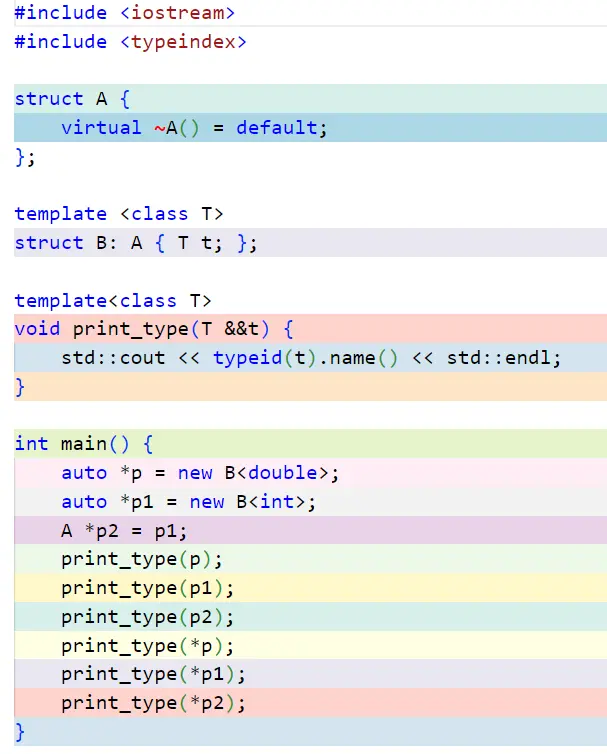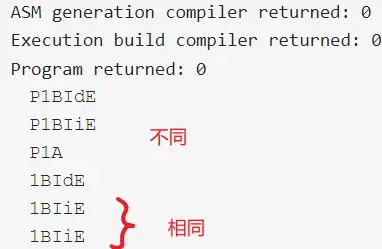type_index
例子:bustub lab 0
可以和 📌vtable 联系起来看。
dynamic_cast 何时可以使用?
使用要求:① 目标是类的指针或引用 ② 目标类含虚表
我最初在 bustub lab 0 的实现中使用了向下转型的操作:在 Get 操作中,当一个 TrieNode 有值的时候,就尝试向下转型为 TrieNodeWithValue<T>,这一步仍然正确就说明类型也正确,可以取出返回。
在 Compiler Explorer 中实现相似操作:
struct A {};
template <class T>
struct B: A { T t; };
int main() {
auto *p = new A;
if (auto pb = dynamic_cast<B<int> *>(p)) {}
}
结果说 A 没有多态性:
<source>: In function 'int main()':
<source>:12:19:error:cannot 'dynamic_cast' 'p' (of type 'struct A*') to type 'struct B<int>*' (source type is not polymorphic)
12 | if (auto pb =dynamic_cast<B<int> *>(p)) {}
|^~~~~~~~~~~~~~~~~~~~~~~~~
ASM generation compiler returned: 1
<source>: In function 'int main()':
<source>:12:19:error:cannot 'dynamic_cast' 'p' (of type 'struct A*') to type 'struct B<int>*' (source type is not polymorphic)
12 | if (auto pb =dynamic_cast<B<int> *>(p)) {}
|^~~~~~~~~~~~~~~~~~~~~~~~~
Execution build compiler returned: 1
这是因为 A 没有虚表。想要使用 dynamic_cast 功能,需要给 A 加虚表,也就是说只要一个虚函数就可以了:
struct A {
virtual ~A() = default;
};
template <class T>
struct B: A { T t; };
int main() {
auto *p = new A;
if (auto pb = dynamic_cast<B<int> *>(p)) {}
}
上面的代码就能够正常编译。
尝试用 std::type_index 代替 dynamic_cast?
可以用 std::type_index 来唯一标记数据的类型,该结构占用 8 个字节,且能够作为 key 放入容器中。std::type_index 能够判断一个类是不是目标类型,而 dynamic_cast 能够判断一个类是不是目标类型或其子类,所以前者的判断更加精确。
在 bustub 的例子中,由于 TrieNodeWithValue<T> 在不同的 T 之间没有继承关系,所以 dynamic_cast 成功后可以确定是相同的类型,能满足功能的要求。
💡 理论上,如果 B 继承于 A,那么从一个包含 B 对象的结点获取 A 类型的指针也应该是可能的。但是 TrieNodeWithValue<B> 并不继承于 TrieNodeWithValue<A>,这使得涉及向上转型的 Get 操作无法在给定的代码中实现,从而本质上是完成了“精确获取”。
💡 std::type_index 需要结合 typeid 来使用,std::type_index 和 typeid 都有唯一性,但是 typeid(expr_or_type).name() 不一定有。详见 cppreference。
typeid 对类型的判断也有动态性:


可以看到 typeid 对 *p2 的类型判断是真实的。
另外注意到
动态类型转换 的 dynamic_cast 实现第 5 步对类型做了相等判断,对于类型完全一致的转换情况,能够直接返回结果。所以在 bustub 的场景下 dynamic_cast 只有转换失败时才比 typeid + type_index + dynamic_cast 的判断慢。
我简单测了一下用 dynamic_cast 和 type_index 方法的时间花销:
benchmark 代码:本地 GCC 10.2 -O0
#include <iostream>
#include <typeindex>
#include <chrono>
#include <vector>
struct A { virtual ~A() = default; };
template <class T>
struct B: A { T t; };
int main() {
const int loop_count = 10000;
std::vector<decltype(std::chrono::steady_clock::now())> time_points;
time_points.reserve(16); // do not resize later
auto tick = [&]() { time_points.push_back(std::chrono::steady_clock::now()); };
auto *p1 = new B<int>;
A *p2 = p1;
tick();
for (int i = 0; i < loop_count; ++i) {
if (auto p3 = dynamic_cast<B<int> *>(p2)) {
; // nop
}
}
tick();
for (int i = 0; i < loop_count; ++i) {
if (auto p3 = dynamic_cast<B<double> *>(p2)) {
; // nop
}
}
tick();
for (int i = 0; i < loop_count; ++i) {
B<int> *p3;
if (std::type_index(typeid(B<int>)) == std::type_index(typeid(*p2))
&& (p3 = dynamic_cast<B<int> *>(p2))) {
; // nop
}
}
tick();
for (int i = 0; i < loop_count; ++i) {
B<double> *p3;
if (std::type_index(typeid(B<double>)) == std::type_index(typeid(*p2))
&& (p3 = dynamic_cast<B<double> *>(p2))) {
; // nop
}
}
tick();
for (int i = 0; i < loop_count; ++i) {
B<int> *p3;
if (std::type_index(typeid(B<int>)) == std::type_index(typeid(*p2))
&& (p3 = reinterpret_cast<B<int> *>(p2))) {
; // nop
}
}
tick();
for (int i = 0; i < loop_count; ++i) {
B<double> *p3;
if (std::type_index(typeid(B<double>)) == std::type_index(typeid(*p2))
&& (p3 = reinterpret_cast<B<double> *>(p2))) {
; // nop
}
}
tick();
auto print_time = [&](int i, const char *tag) {
auto d = time_points[i] - time_points[i-1];
std::cout << tag << ": "
<< std::chrono::duration_cast<std::chrono::microseconds>(d).count()
<< " μs\n";
};
print_time(1, "[success] dynamic_cast");
print_time(2, "[failure] dynamic_cast");
print_time(3, "[success] type_index + dynamic_cast");
print_time(4, "[failure] type_index + dynamic_cast");
print_time(5, "[success] type_index + reinterpret_cast");
print_time(6, "[failure] type_index + reinterpret_cast");
}
结果:
xxx@yyy:/tmp/v$ g++ main.cpp -O0 && ./a.out
[success] dynamic_cast: 73 μs
[failure] dynamic_cast: 128 μs
[success] type_index + dynamic_cast: 136 μs
[failure] type_index + dynamic_cast: 99 μs
[success] type_index + reinterpret_cast: 89 μs
[failure] type_index + reinterpret_cast: 97 μs
事实证明在 bustub + O0 优化的场景中:
reinterpret_cast能够比dynamic_cast节约一点时间。- 失败的场景下先检查
type_index再转换会比dynamic_cast更快。 - 成功的场景下
dynamic_cast快于type_index检查后转换。
由于怀疑 dynamic_cast 是用了优化选项编译的,而我的 type_index 检查没有用优化选项而吃亏,接下来看 -O2 优化的结果(这里不用 O3 优化是因为 O3 优化已经看出来了失败的分支是一定失败的,查类型的操作被优化删了)
benchmark 代码:本地 GCC 10.2 -O2
#include <iostream>
#include <typeindex>
#include <chrono>
#include <optional>
#include <vector>
struct A { virtual ~A() = default; };
template <class T>
struct B: A { T t; };
void doNotOptimize() {
static volatile int a;
a = 0;
}
int main() {
const int loop_count = 10000;
std::vector<decltype(std::chrono::steady_clock::now())> time_points;
time_points.reserve(16); // do not resize later
auto tick = [&]() { time_points.push_back(std::chrono::steady_clock::now()); };
auto *p1 = new B<int>;
A *p2 = p1;
tick();
for (int i = 0; i < loop_count; ++i) {
if (auto p3 = dynamic_cast<B<int> *>(p2)) {
doNotOptimize();
}
}
tick();
for (int i = 0; i < loop_count; ++i) {
if (auto p3 = dynamic_cast<B<double> *>(p2)) {
doNotOptimize();
}
}
tick();
for (int i = 0; i < loop_count; ++i) {
B<int> *p3;
if (std::type_index(typeid(B<int>)) == std::type_index(typeid(*p2))
&& (p3 = dynamic_cast<B<int> *>(p2))) {
doNotOptimize();
}
}
tick();
for (int i = 0; i < loop_count; ++i) {
B<double> *p3;
if (std::type_index(typeid(B<double>)) == std::type_index(typeid(*p2))
&& (p3 = dynamic_cast<B<double> *>(p2))) {
doNotOptimize();
}
}
tick();
for (int i = 0; i < loop_count; ++i) {
B<int> *p3;
if (std::type_index(typeid(B<int>)) == std::type_index(typeid(*p2))
&& (p3 = reinterpret_cast<B<int> *>(p2))) {
doNotOptimize();
}
}
tick();
for (int i = 0; i < loop_count; ++i) {
B<double> *p3;
if (std::type_index(typeid(B<double>)) == std::type_index(typeid(*p2))
&& (p3 = reinterpret_cast<B<double> *>(p2))) {
doNotOptimize();
}
}
tick();
auto print_time = [&](int i, const char *tag) {
auto d = time_points[i] - time_points[i-1];
std::cout << tag << ": "
<< std::chrono::duration_cast<std::chrono::microseconds>(d).count()
<< " μs\n";
};
print_time(1, "[success] dynamic_cast");
print_time(2, "[failure] dynamic_cast");
print_time(3, "[success] type_index + dynamic_cast");
print_time(4, "[failure] type_index + dynamic_cast");
print_time(5, "[success] type_index + reinterpret_cast");
print_time(6, "[failure] type_index + reinterpret_cast");
}
结果:
xxx@yyy:/tmp/v$ g++ main.cpp -O2 && ./a.out
[success] dynamic_cast: 60 μs
[failure] dynamic_cast: 124 μs
[success] type_index + dynamic_cast: 67 μs
[failure] type_index + dynamic_cast: 23 μs
[success] type_index + reinterpret_cast: 7 μs
[failure] type_index + reinterpret_cast: 22 μs
现在 dynamic_cast 已经完全没有优势了。
reinterpret_cast 安全吗?
可以参考 p1839r5.pdf,截至2023年4月30日,用非字节手段 访问对象表示 的确是 UB。但是根据 cppreference,如果指针指向的确实是该同类型的对象,那么访问不算是 UB。对于指针之间的转换,由于 bustub 的 TrieNode 和 TrieNodeWithValue<T> 确有继承关系,所以也不是 UB。
对于 Lab 2 中遇到的通过零大小数组越界访问实现 B 树的情况,没有涉及到指针转换,所以不是 UB。alignment 也没有问题,因为零大小数组也是数组,其 alignment 和元素一致。
[2023年6月3日] 这里使用 static_cast 比较好,因为它可以修正指针偏移。reinterpret_cast 则只能适用于单继承的情况。下面就懒得提这个问题了。
type_index 的使用正确吗?
- 考虑到不同动态链接库中同一种类型可能有不同的
type_index,这一点又要斟酌。但是,dynamic_cast也有同样的问题!所以如果dynamic_cast适用,type_index当然也适用。 - 另一方面,这里借助了
typeid来访问 type_index,能够正确处理指针动态转换后地址偏移的问题。
还想更快?存储 type_index 空间换时间
如果愿意多占用一些内存,可以在 TrieNodeWithValue 中加一个类型域,存储 std::type_index,就能通过比较 type_index 再 interpret_cast 来避免运行时类型查找得开销,见
虚表和类型表的布局;而直接存储下来只需要访存一次)。对于空结点,使用 std::type_index(typeid(void)) 来初始化 type_index。当类型本身没必要加虚表的时候,这个 std::type_index 对象刚好就能替代掉虚表指针占用的 8 个字节的空间。
std::cout << typeid(void).name() << '\n';在 GCC 13.1 的输出是"v\n",这说明 void 也是有type_info(typeid表达式的类型)的。
另外,如果不需要抹去类型(毕竟存 index 则不必记住原来的类型),可以直接比较 typeid() 的返回值(写起来比创建 std::type_index 方便),因为 std::type_info 重载了比较操作符。
读 std::type_info 的开销
BaseObject *p = new DerivedObject;
// vtable_prefix = { whole_object, whole_type, origin }
// 以下每行读取内存一次
char *vptr = *(char **)p;
long offset = *(long *)(vptr - sizeof(long) * 2);
char *realvptr = *(char **)(p + offset);
// __class_type_info 继承于 std::type_info
__class_type_info *info = *(__class_type_info **)(realvptr - sizeof(long));
比较 std::type_info 的开销
删掉了一些条件编译宏,下面是一个版本的比较方式(也就是比较 std::type_info::name() 字符串,注意 _name 开头为 * 的话有特殊含义),可以看到动态比较 std::type_info 是比较字符串。
_GLIBCXX23_CONSTEXPR inline bool
type_info::operator==(const type_info& __arg) const _GLIBCXX_NOEXCEPT
{
if (std::__is_constant_evaluated())
return this == &__arg;
if (__name == __arg.__name)
return true;
return __name[0] != '*' && __builtin_strcmp (__name, __arg.name()) == 0;
}
比较 std::type_index 的开销
std::type_index 包含了一个 std::type_info 的指针,比较运算符会转发到 std::type_info 的比较上,内联之后代价一样。